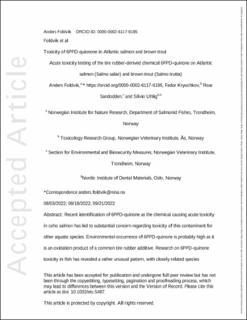Acute toxicity testing of the tire rubber-derived chemical 6PPD-quinone on Atlantic salmon (Salmo salar) and brown trout (Salmo trutta)
Peer reviewed, Journal article
Accepted version

Åpne
Permanent lenke
https://hdl.handle.net/11250/3033609Utgivelsesdato
2022Metadata
Vis full innførselSamlinger
- Publikasjoner fra CRIStin - NINA [2364]
- Scientific publications [1392]
Originalversjon
10.1002/etc.5487Sammendrag
Recent identification of 6PPD-quinone as the chemical causing acute toxicity in coho salmon has led to substantial concern regarding toxicity of this contaminant for other aquatic species. Environmental occurrence of 6PPD-quinone is probably high as it is an oxidation product of a common tire rubber additive. Research on 6PPD-quinone toxicity in fish has revealed a rather unusual pattern, with closely related species exhibiting responses ranging from extreme sensitivity to no effect. Of eleven previously studied fish species, 6PPD-quinone was toxic to four. The species-specific toxicity of 6PPD-quinone complicates urgently needed environmental risk assessment. We investigated acute toxicity of 6PPD-quinone in Atlantic salmon and brown trout alevins (sac fry). These species have previously not been tested for sensitivity to 6PPD-quinone. The fish were exposed in static conditions in eight treatments with initial concentrations ranging from 0.095–12.16 µg/L. Fish were observed for 48 h and changes in concentrations of 6PPD-quinone were monitored throughout the experiment. No mortalities or substantial changes in behaviour were recorded in either Atlantic salmon or brown trout. This provides an important first step in assessing effects of 6PPD-quinone on these highly economically and culturally important species.
